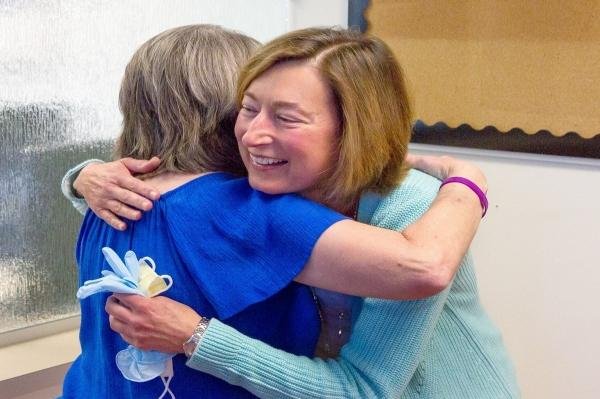Tammy Griffin and Linda Karr, at right, meet for the first time after the total strangers were part of a rare domino transplant. Griffin received a lung and a new heart from an organ donor, and donated her heart to Karr. Photo by Stanford University
STANFORD, Calif., March 30 (UPI) -- Doctors at Stanford hospital completed an exceptionally rare "domino" surgery, giving one patient a heart-lung transplant, and then sending her heart to another woman.
Although hearts and lungs from organ donors generally are separated to help two patients, a woman with cystic fibrosis was best treated with the double transplant, allowing doctors to use her heart for a woman with a rare genetic heart condition, doctors reported.
Domino surgeries are rare -- only eight have ever been performed at Stanford, with the last completed in 1994 -- but are often useful for situations where patients require a transplant, but their organs are still usable. In many cases, domino tranplants are used for kidney or liver transplant patients because of difficulties getting organs, such as those performed at the Mayo Clinic and a six-hospital, 12-patient transplant led by Johns Hopkins University in 2009.
"We hope this story will raise awareness how scarce organs are," Dr. Joseph Woo, a professor of cardiovascular surgery at Stanford University, said in a press release. "People are waiting and dying on those transplant lists. We would like to see that change."
Tammy Griffin, 51, has cystic fibrosis and was on oxygen constantly, with barely enough energy to stand up for a full shower with sitting down to rest. While her heart was functioning well, it was pushed out of its position between the lungs as her right lung shrank and left one expanded. Because of the displacement, the heart-lung transplant was her only option.
On January 29, Griffin was told by doctors to fly to California from her home in Oregon because a donor had been found for her.
The next day, the doctors called Linda Karr, 53, that a heart donor had been located for her, despite her low position on the donor list and fears she wouldn't survive long enough to have a shot at a heart. Karr was diagnosed with right ventricular dysplasia, a genetic disease that causes an abnormal heart rhythm.
Doctors removed Griffin's heart and lungs, replacing them with the set from an organ donor, before taking her heart to another operating room where it was transplanted into Karr's chest.
"Sometimes hearts don't start up on their own, but in Karr's case, Griffin's heart started right up -- and in a pretty normal rhythm," he said. "It was truly awesome."
Both Karr and Griffin are now recovering, and have met each other. Both women say they feel they've been given a second chance at life because of the transplants -- and meeting each other, with Griffin listening to her old heart beat in Karr's chest.
Tammy Griffin, left, listens to her old heart in Linda Karr's chest after a domino transplant got both women new hearts, and Griffin a new pair of lungs. Photo by Stanford University
"I didn't want my heart thrown away," Griffin said, "and I thought I'll be able to meet the person who has my heart! How many people can say that?"
















